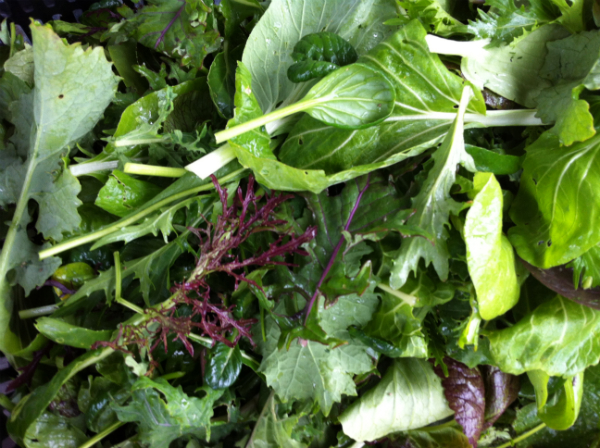Braising Mix
/Braising MixOur braising mix is a new item at Transition Farm, arriving in your share during the cooler months of spring and autumn when the many varieties of kale, mustard, and Asian chois that make up this mix thrive. You will enjoy green, red and purple mustards, red choi, tatsoi, white steamed pac choi, mibuna, mizuna, Red Russian kale, green kale and silverbeet in the flavorful mix of "greens".
The greens are harvested at mid-maturity, so they are much milder in taste than the same varieties when full grown, but have more flavor than when harvested as baby greens and eaten raw. They are an unusual taste explosion of peppery, sweet, earthy, bitter and nutty.
Cooking Tips Braising mixes are usually cooked. Named after the cooking technique of searing in hot oil and then simmering in liquid, braising greens can in fact be steamed, sauteed, stir-fried, or mixed into soups or stews. Braising greens are the perfect addition to salads, stir-fries, pizza, pasta, eggs, or casseroles. From Tufts University:
- Toss a couple handfuls of braising mix (baby chard, kale, spinach, mustard, arugula, or other greens) into a stir fry.
- Be sure to balance the slight bitterness of baby chard, dandelion or mustard leaves with contrasting or sweet flavors such as persimmon, apple, pear, baby beets, citrus, vinaigrette spiked with honey or a syrupy balsamic vinegar.
- You can also toss some chopped greens into soup or a frittata, or serve them sauteed with pancetta, pine nuts, and golden raisins and heaped atop crusty toasted or grilled bread rubbed with garlic.
Storage Tips These greens are a bit hardier, so they should store relatively well in a plastic bag in the crisper drawer of your refrigerator for at least a week. Still, they should generally be used sooner if possible.
Nutrition Because braising mix contains many different varieties of greens, each harvest may be nutritionally different. But because it contains many types of brassicas, braising greens are always rich in vitamins A and C, calcium, iron, folacin and beta carotene.
Field Notes The plants that make up our braising mix, although different looking and tasting, are almost all from the wonderfully diverse Brassica Rapa species. These plants thrive in the cool weather of the Peninsula in Spring and late Autumn. Each component is seeded separately in the field and mixed at harvest time. We try and harvest the braising mix when it is in it's "teenage" stage so that the leaves are still tender.
Recipes There are recipes on our website recipe page.














